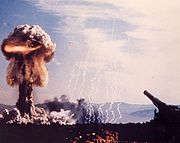
W9 (nuclear warhead)
Encyclopedia

Nuclear artillery
Nuclear artillery is a subset of limited-yield tactical nuclear weapons, in particular those weapons that are launched from the ground at battlefield targets...
shell fired from a special 11 inch howitzer. It was produced starting in 1952 and all were retired by 1957.
Description
The W9 was 11 inches (280 mm) in diameter, 55 inches (138 cm) long, and weighed 850 pounds (364 kg). It had an explosive yield of 15 kilotons.The W9 was a gun-type
Gun-type fission weapon
Gun-type fission weapons are fission-based nuclear weapons whose design assembles their fissile material into a supercritical mass by the use of the "gun" method: shooting one piece of sub-critical material into another...
nuclear weapon, utilizing around 50 kilograms of highly enriched uranium in one large rings assembly and one smaller "bullet", which was fired down a tube by conventional explosives into the rings assembly to achieve critical mass
Critical mass
A critical mass is the smallest amount of fissile material needed for a sustained nuclear chain reaction. The critical mass of a fissionable material depends upon its nuclear properties A critical mass is the smallest amount of fissile material needed for a sustained nuclear chain reaction. The...
and detonate the weapon.
The W9 units which were retired in 1957 were recycled into lower yield T-4 Atomic Demolition Munition
T-4 Atomic Demolition Munition
The T4 Atomic Demolition Munitions were modified versions of the W9 nuclear artillery shells.-History:The T4 was produced in 1957 from recycled W9 fissile components and was in service until 1963, when it was replaced with W30 Tactical Atomic Demolition Munitions and W45 Medium Atomic Demolition...
s. These were the first (semi) man-portable nuclear weapons.
Tests
The W9 is only the second gun-type nuclear weapon known to have been detonated; the first was the Little BoyLittle Boy
"Little Boy" was the codename of the atomic bomb dropped on Hiroshima on August 6, 1945 by the Boeing B-29 Superfortress Enola Gay, piloted by Colonel Paul Tibbets of the 393rd Bombardment Squadron, Heavy, of the United States Army Air Forces. It was the first atomic bomb to be used as a weapon...
nuclear weapon used in World War 2.
The W9 artillery shell was test fired once, in Upshot-Knothole Grable
Upshot-Knothole Grable
Upshot-Knothole Grable was a nuclear weapons test conducted by the United States as part of Operation Upshot-Knothole. Detonation of the associated nuclear weapon occurred shortly after its deployment at 8:30am PDT on May 25, 1953, in Area 5 of the Nevada Test Site...
on May 25, 1953. Yield was the expected 15 kilotons.
Subsequently, the W33 nuclear artillery shell was test fired twice during its development process. These four detonations are the only identified gun-type bomb detonations.

